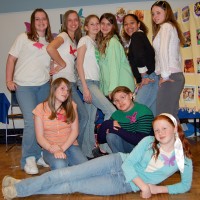I listened to Speaking of Faith this morning while I did yoga. I use this routine to focus on spirituality and fitness; it’s easier for me to meditate when I’m moving! This week’s podcast was titled “Fishing with Mystery” and James Prosek said that creativity is our gift from the Creator. Discovering our own creativity and expressing it is a form of worship. From there my mind wandered back to the workshop Rachel Rockwell facilitated for Chrysalis After-School facilitators and mentors yesterday.
She worked with us on creating paintings and stories in the safe, respectful environment of Culture Inc. Afterward, one of the facilitators said she always becomes anxious when she is in a situation where she has to create. I think a lot of people feel that way, as we have had the products of our creativity judged and sometimes gotten little support.
I think it might help me to use James Prosek’s metaphor of connecting to the creative pipeline when I sit down to create. At times, I’ve experienced that connection when I’ve painted, written grants, facilitated groups. I think it comes more from letting go than from trying really hard. And again, it’s a process and learning experience.
Then there is the discipline required for creativity; I’ve found I need order. Stephen King requires himself to write 2,000 words each day before he does much else. The Artist’s Way recommends morning pages–two pages of writing first thing in the morning in a stream of consciousness mode.
So creativity is a sum of at least two parts–tapping into the pipeline and discipline–available to most of us.












